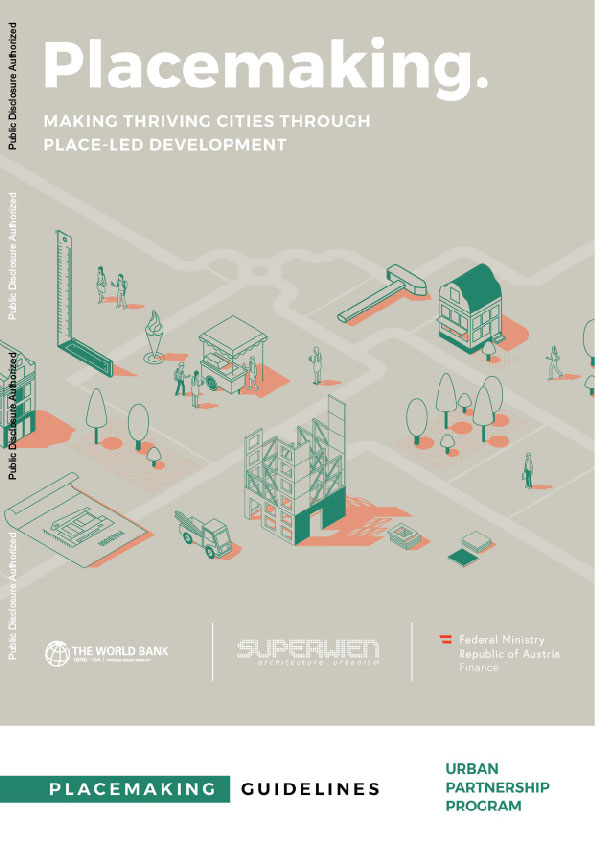PLACEMAKING: MAKING THRIVING CITIES THROUGH PLACE-LED DEVELOPMENT
Placemaking Guide
Year
2021
Status
published
Location
–
Collaboration
World Bank
Client
–
EN
This placemaking guide builds on the experiences of the World Bank Group activity “Piloting Participatory Approaches for Urban Development in Serbia—Placemaking” and on other activities implemented under Urban Partnership Program (UPP), among them the workshops conducted in Ksamil, as well as the report Urban Regeneration Strategy for the town of Ksamil in Saranda, Albania that produced the Ksamil Integrated Urban Regeneration Concept (“Ksamil Urban Lab”).
Since June 2019, the World Bank has supported not only Serbian city administrations and their staff by strengthening their capacity, but also NGOs, activists, and universities with innovative concepts about participatory planning techniques that include placemaking and place-led development.
In workshops in Niš, Belgrade, and Novi Sad, three different case studies were explored with the diverse groups of participants: In Niš the team worked on incorporating the river strategically into the city center and how to activate it for the benefit of all citizens. In Belgrade the team worked on central public spaces around transportation hubs. And in Novi Sad the team worked on selected site that was planned to be part of Cultural Identity and Arts during the city’s term as European Capital of Culture 2022.
This guide allows us to share the knowledge gained from these projects about placemaking and participatoryplanning in the Western Balkans region and to position the concept of place-led development as part of sustainable urban planning and design in the region. The goal of the report is to make the knowledge and concepts available to local administrators, civil servants, professionals in academic positions, architects, urban planners and other representatives of local administrations, as well as NGO representatives and students/young professionals who want to integrate placemaking tools into their own work.
The guide introduces the concept of placemaking and place-led urban development, its origins, and its place in the history of urban planning, giving a range of definitions and interpretations to support broad understanding of placemaking. References to similar but distinguishable concepts help to better delimit placemaking, its main benefits, and its limits.
https://documents1.worldbank.org/curated/en/812431627454312133/pdf/Making-Thriving-Cities-Through-Place-Led-Development-Placemaking-Guide.pdf
DE
Dieser Placemaking-Leitfaden basiert auf den Erfahrungen der Aktivität der Weltbankgruppe „Piloting Participatory Approaches for Urban Development in Serbia—Placemaking“ sowie auf weiteren Maßnahmen im Rahmen des Urban Partnership Program (UPP), darunter die in Ksamil durchgeführten Workshops und der Bericht „Urban Regeneration Strategy for the town of Ksamil in Saranda, Albania“, aus dem das integrierte Stadtentwicklungskonzept „Ksamil Urban Lab“ hervorgegangen ist.
Seit Juni 2019 unterstützt die Weltbank nicht nur serbische Stadtverwaltungen und deren Mitarbeitende durch Kapazitätsaufbau, sondern auch NGOs, Aktivist:innen und Universitäten mit innovativen Konzepten zu partizipativen Planungsmethoden, einschließlich Placemaking und Place-led Development.
In Workshops in Niš, Belgrad und Novi Sad wurden drei verschiedene Fallstudien gemeinsam mit unterschiedlichen Gruppen bearbeitet: In Niš arbeitete das Team an der strategischen Integration des Flusses in das Stadtzentrum und daran, wie er für alle Bürger:innen aktiviert werden kann. In Belgrad lag der Fokus auf zentralen öffentlichen Räumen rund um Verkehrsknotenpunkte. In Novi Sad wurde an einem Standort gearbeitet, der als Teil der kulturellen Identität und der Künste im Rahmen des Titels „Europäische Kulturhauptstadt 2022“ vorgesehen war.
Dieser Leitfaden ermöglicht es, das in diesen Projekten gewonnene Wissen über Placemaking und partizipative Planung in der Westbalkanregion zu teilen und das Konzept des Place-led Development als Bestandteil nachhaltiger Stadtplanung und -gestaltung in der Region zu positionieren.
Ziel des Berichts ist es, die entwickelten Konzepte und Methoden lokalen Verwaltungsmitarbeitenden, Beamten, Fachleuten aus Wissenschaft und Praxis, Architekt:innen, Stadtplaner:innen sowie NGO-Vertreter:innen und Studierenden/jungen Fachkräften zugänglich zu machen, die Placemaking-Werkzeuge in ihre eigene Arbeit integrieren möchten.
Der Leitfaden führt in das Konzept von Placemaking und ortsbasierter Stadtentwicklung ein, erläutert dessen Ursprünge und Rolle in der Geschichte der Stadtplanung und bietet eine Vielzahl an Definitionen und Interpretationen, um ein breites Verständnis zu ermöglichen. Verweise auf ähnliche, aber abgrenzbare Konzepte helfen, Placemaking klarer zu definieren, seine Hauptvorteile aufzuzeigen und auch auf mögliche Grenzen hinzuweisen.

